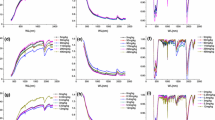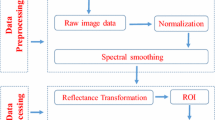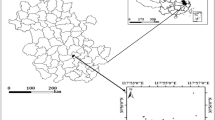Abstract
Aiming at the problem that the accuracy of the results obtained by traditional methods is low, the spectral detection in soil pollution component detection method is used to design multicolor heavy metal image identification. The soil reflectance spectra were measured using an ASD Fieldspec FR spectrometer to obtain soil heavy metal spectral data. Spectral absorption bands, spectral transformations and combinations, correlation analysis, and curve fitting operations are used to process and analyze spectral data. Among them, spectral transformation and combination are used to decompose overlapping mixed spectra by first-order and second-order differential operations, to expand the spectral characteristics of heavy metals in different soils, and to extract high-quality spectral data of soil heavy metals. The spectral data is combined with Newton’s classic rainbow spectrum to obtain different heavy metal spectral colors. Based on this, multicolor image identification of soil pollution components is designed. The results show that the multicolor heavy metal image identification can be used to design the multicolor heavy metal image identification by the spectral detection in the soil pollution component detection method, and it can play the pollution warning role.






Similar content being viewed by others
References
Brummelhuis NT, Wilke P, Börner HG (2017) Identification of functional peptide sequences to lead the design of precision polymers. Macromol Rapid Commun 38(24):1700632
Caporale AG, Adamo P, Capozzi F, Langella G, Terribile F, Vingiani S (2018) Monitoring metal pollution in soils using portable-XRF and conventional laboratory-based techniques: evaluation of the performance and limitations according to metal properties and sources. Sci Total Environ 643:516–526
Cui K, Cai H, Chen GQ et al (2018) Multi-view face detection algorithm based on multi-texture CS-LBP features. J Jilin Univ (Science Edition) 56(3):610–616
Gadalla M, Xue D (2017) An approach to identify the optimal configurations and reconfiguration processes for design of reconfigurable machine tools. Int J Prod Res 4:1–21
Guan X, Chakrabarti R (2017) Molecular system identification for enzyme directed evolution and design. J Chem Phys 147(12):124106
Gupta S, Gupta A (2017) A set of measures designed to identify overlapped instances in software defect prediction. Computing 99(9):1–26
Hellmann E, Swinka C, Heyl A (2017) Novel in vivo screening design for the rapid and cost-effective identification of transcriptional regulators. Physiol Plant 160(1):2–10
Huang ZQ, Fu CP, Wang L et al (2018) Construction site management and control technology based on UAV visual surveillance. Autom Instrum 4:102–105
Jing F, Zhou LW, Lu WG (2017) Design of power quality monitoring terminal based on adaline neural. J Power Supp l15(3):118–125
Mamontov AA, Tarasova EN, Mamontova EA (2018) Persistent organic pollutants in soils of southern Baikal. Russ J Gen Chem 88(13):2862–2870
Martin AP, Ohneiser C, Turnbull RE, Strong DT, Demler S (2018) Soil magnetic susceptibility mapping as a pollution and provenance tool: an example from southern New Zealand. Geophys J Int 212(2):1225–1236
Monti A, Toscano A, Bilotti F (2017) Analysis of the scattering and absorption properties of ellipsoidal nanoparticle arrays for the design of full-color transparent screens. J Appl Phys 121(24):2337–2347
Pawlus W, Birkeland JT, Khang HV et al (2017) Identification and experimental validation of an induction motor thermal model for improved drivetrain design. IEEE Trans Ind Appl 53(5):4288–4297
Ramdani S, Amar A, Belhsaien K et al (2018) Assessment of heavy metal pollution and ecological risk of roadside soils in Tlemcen (Algeria) using flame-atomic absorption spectrometry. Anal Lett 51(15):1–20
Rosen V, Chen Y (2018) Effects of compost application on soil vulnerability to heavy metal pollution. Environ Sci Pollut Res 25(2):35221–35231
Varley JB, Miglio A, Ha VA, van Setten MJ, Rignanese GM, Hautier G (2017) High-throughput design of non-oxide p-type transparent conducting materials: data mining, search strategy, and identification of boron phosphide. Chem Mater 29(6):2568–2573
Xiao C, Zhao T (2017) Identification method of emi sources based on measured single-channel signal and its application in aviation secondary power source design. IEEE Trans Electromagn Compat 59(2):439–446
Yao H, Ren XM, Na W et al (2017) Research on design of vehicle power battery management system testing equipment. Chin J Power Sources 41(10):1464–1466
Yu XL, Xu YJ, Zhuo ZX (2017) Sparse event detection based on parallel discrete social spider optimization algorithm and compressed sensing in wireless sensor networks. J China Acad Electron Inf Technol 12(2):202–208
Zhan N, Guo F, Tian Q et al (2017) Screening and quantification of organic pollutants in soil using comprehensive two-dimensional gas chromatography with time-of-flight mass spectrometry. Anal Lett 51(7):955–970
Acknowledgement
The research results of the 2019 education science planning project of the 13th five year plan of Shanxi Education Science Application Research of Shanxi traditional art resources in art education of colleges and universities (subject No.: GH-19131).
Author information
Authors and Affiliations
Corresponding author
Additional information
This article is part of the Topical Collection on Geological Modeling and Geospatial Data Analysis
Rights and permissions
About this article
Cite this article
Han, T. Design and application of multicolor image identification in soil pollution component detection. Arab J Geosci 13, 905 (2020). https://doi.org/10.1007/s12517-020-05873-y
Received:
Accepted:
Published:
DOI: https://doi.org/10.1007/s12517-020-05873-y




